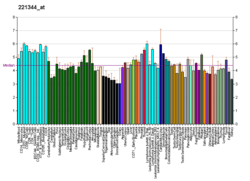OR12D2
Olfactory receptor, family 12, subfamily D, member 2, also known as OR12D2, is a protein which in humans is encoded by the OR12D2 gene.[5]
Function
Olfactory receptors interact with odorant molecules in the nose, to initiate a neuronal response that triggers the perception of a smell. The olfactory receptor proteins are members of a large family of G-protein-coupled receptors (GPCR) arising from single coding-exon genes. Olfactory receptors share a 7-transmembrane domain structure with many neurotransmitter and hormone receptors and are responsible for the recognition and G protein-mediated transduction of odorant signals. The olfactory receptor gene family is the largest in the genome. The nomenclature assigned to the olfactory receptor genes and proteins for this organism is independent of other organisms.[5]
References
- ENSG00000225247, ENSG00000233481, ENSG00000235966, ENSG00000280236, ENSG00000204690 GRCh38: Ensembl release 89: ENSG00000227446, ENSG00000225247, ENSG00000233481, ENSG00000235966, ENSG00000280236, ENSG00000204690 - Ensembl, May 2017
- GRCm38: Ensembl release 89: ENSMUSG00000092077 - Ensembl, May 2017
- "Human PubMed Reference:". National Center for Biotechnology Information, U.S. National Library of Medicine.
- "Mouse PubMed Reference:". National Center for Biotechnology Information, U.S. National Library of Medicine.
- "Entrez Gene: OR12D2 olfactory receptor, family 12, subfamily D, member 2".
Further reading
- Younger RM, Amadou C, Bethel G, et al. (2001). "Characterization of clustered MHC-linked olfactory receptor genes in human and mouse". Genome Res. 11 (4): 519–30. doi:10.1101/gr.gr-1603r. PMC 311051. PMID 11282967.
- Strausberg RL, Feingold EA, Grouse LH, et al. (2003). "Generation and initial analysis of more than 15,000 full-length human and mouse cDNA sequences". Proc. Natl. Acad. Sci. U.S.A. 99 (26): 16899–903. Bibcode:2002PNAS...9916899M. doi:10.1073/pnas.242603899. PMC 139241. PMID 12477932.
- Mungall AJ, Palmer SA, Sims SK, et al. (2003). "The DNA sequence and analysis of human chromosome 6". Nature. 425 (6960): 805–11. Bibcode:2003Natur.425..805M. doi:10.1038/nature02055. PMID 14574404.
- Malnic B, Godfrey PA, Buck LB (2004). "The human olfactory receptor gene family". Proc. Natl. Acad. Sci. U.S.A. 101 (8): 2584–9. Bibcode:2004PNAS..101.2584M. doi:10.1073/pnas.0307882100. PMC 356993. PMID 14983052.
- Gerhard DS, Wagner L, Feingold EA, et al. (2004). "The status, quality, and expansion of the NIH full-length cDNA project: the Mammalian Gene Collection (MGC)". Genome Res. 14 (10B): 2121–7. doi:10.1101/gr.2596504. PMC 528928. PMID 15489334.
External links
This article incorporates text from the United States National Library of Medicine, which is in the public domain.




